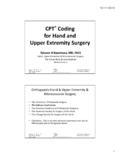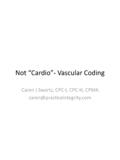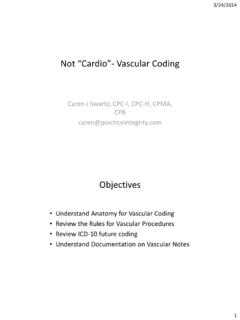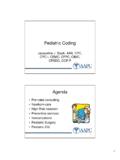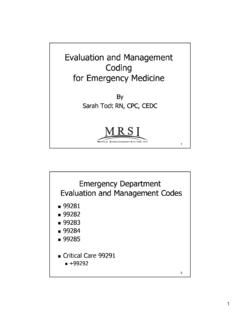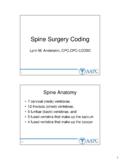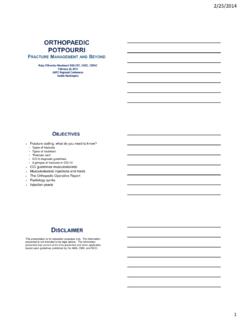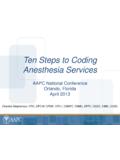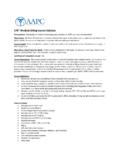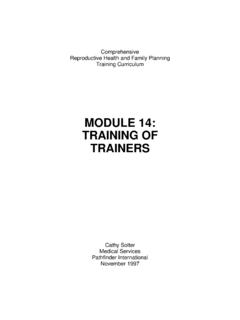Transcription of Coding Skin Procedures in the Office Setting
1 1/26/2010 1 1 Coding Skin Procedures in the Office SettingWritten and Presented bySusan Ward, CPC, CPC-H, CPC-I, CPCD, CEMC, CPRCAll Rights Reserved AAPC 2 DisclaimerThe information you are receiving today is based on the experience and knowledge of the presenter. Opinions may vary regarding scenarios presented. This presentation is for educational and informational purposes material in this presentation is not intended as a substitute for the Coding rights reserved. No part of this publication may be reproduced in any form or by any means without the express written permission of the presenter.
2 1/26/2010 2 3 Agenda Proper Coding Know and understand the problem areas. Closures How to determine the proper closure code. Diagnosis How to properly code the diagnosis. Modifiers When is the use of modifiers correct? 4 Anatomy of the Skin 1/26/2010 3 5 Incision & DrainageCode Set 10040 10180 10040 Acne surgery 10060 10061 Incision and drainage abscess; simple or single Incision and drainage abscess; complicated or multiple 10080 10081 Incision and drainage pilonidal cyst; simple Incision and drainage pilonidal cyst; complicated 6 DebridementCodes 11000 11001 11000 Debridement.
3 Up to 10% of body surface 11001 Each additional 10% of body surfaceThese codes are used for the removal of foreign material and devitalized or contaminated tissue from eczematous or infected skin to expose the healthy skin. After debridement, antibiotics or topical lubricants are applied to the skin. Do we use these codes for burns? 1/26/2010 4 7 Injections to LesionsInjection 11900 Injection, intralesional; up to and including 7 lesions 11901 Injection, more than 7 lesions J3301 Kenalog 8 Biopsy vs. Shave Biopsy A biopsy is done to evaluate a suspicious lesion in which your physician may not want to completely excise.
4 There are several methods that can be used for a biopsy. Shave A shave is defined by CPT as the sharp removal by transverse incision or horizontal slicing to remove epidermal and dermal lesions without a full-thickness dermal excision. 1/26/2010 5 9 BiopsyBe very careful: 11100 for your first lesion +11101 of each additional Biopsy of eyelid is 67810 Biopsy of external ear is 69100 Biopsy of Lip is 40490 All codes include a simple closure 10 Coding Lesion Excision Skin Tags 11200 up to and including 15 lesions +11201 each additional 10 lesions Shaving Lesions 11300 11313 Please note size and location determine code selection This does not require suture closure 1/26/2010 6 11 Coding Lesion ExcisionMeasuring and Coding of Lesion Removal Per CPT Excision is defined as full thickness removal of a lesion, including margins.
5 Code selection is based on measuring the greatest clinical diameter of the lesion plus the most narrow margins required for complete excision. 12 Lesion with margins is measured prior to lesion being removedLesion sizeMarginLesion plus Margin equals total excision 1/26/2010 7 13 Benign Lesions 11400 11406 Trunk, arms or legs 11420 11426 Scalp, neck, hands, feet or genitalia 11440 11446 Face, ears, eyelids, nose, lips or mucous membrane 14 Malignant Lesions 11600 11606 Trunk, arms, or legs 11620 11626 Scalp, neck, hands, feet, or genitalia 11640 11646 Face, ears, eyelids, nose, or lips 1/26/2010 8 15 Repairs Repair (Closures) Simple (12001 12021)
6 Superficial, epidermis or dermis Intermediate (12031 12057) Layered, deeper layers of sub-q tissue Complex (13100 13160) Scar revision, debridement, underminingCPT describes repairs as follows: 16 Simple RepairUsed when the wound is superficial. Typically involves the epidermis or dermis without significant involvement of the deeper structure of the skin. A ONE layer closure 1/26/2010 9 17 Intermediate Repair Includes the repair of wounds, that, in addition to what is described in a Simple Repair, require layered closure of one or more of the deeper layers of subcutaneous tissue and superficial (non-muscle) fascia, in addition to the skin closure.
7 Single layer closure of heavily contaminated wounds that have required extensive cleaning or removal of particulate matter also constitutes the use of Intermediate Repair codes. 18 Complex Repair Includes the repair of wounds requiring more than layered closure, such as scar revision, debridement, extensive undermining, stents, or retention sutures. Necessary preparation includes creation of a defect for repairs or the debridement of complicated lacerations or avulsions. Remember Complex Repairs do NOT include the excision of benign or malignant lesions. 1/26/2010 10 19 Flaps and Grafts Flaps (14000 14350) Also known as Z-plasty, W-plasty, Rotation Flap Measured in square cm Grafts (15040-15431) Split Thickness or Full Thickness Allograft or Xenograft 20 Adjacent Tissue TransferAs described per CPT ; excision (including lesion) and/or repair by adjacent tissue transfer or graft necessary to close secondary defect is considered an additional procedure.
8 The primary defect resulting from the excision and the secondary defect resulting from flap design to perform the reconstruction are measured together to determine code selection. 1/26/2010 11 21 Split Thickness and Full Thickness Skin Grafts Code range for STSG 15100 (Trunk, arms and legs) 15120 (Face, scalp, eyelids, mouth, neck, ears, orbits genitalia, hands, feet and/or multiple digits) Code range for FTSG 15200 (Trunk) 15220 (Scalp, arms and legs) 15240 (Forehead, cheeks, chin, mouth, neck, axillae, genitalia, hands and feet) 15260 (Nose, ears, eyelids and lips) 22 Allograft Application of a non-autologous human skin graft) from a donor to a part of the patient s body.
9 Code Range 15300 -15366 1/26/2010 12 23 Xenograft Application of a non-human skin graft or biologic wound dressing (pigskin or porcine tissue) to a part of the patient s body. Code Range 15400 -15431 24 DestructionDestruction, Benign, or Pre-malignant Lesions Destruction by laser surgery, electrosurgery, cryosurgery, chemosurgery or surgical curettement 17000 First lesion (Actinic Keratoses) +17003 Second through 14thlesion; each 17004 15 or more lesions 17106 17108 Cutaneous vascular proliferation 17110 Up to 14 lesions (Not Skin Tags) (Warts) 17111 15 or more lesions 1/26/2010 13 25 DestructionDestruction, Malignant Lesions, Any Method Destruction, malignant lesion, ( , laser surgery, electrosurgery, cryosurgery, chemosurgery, surgical curettement)
10 17260 17266 Trunk, arms or legs 17270 17276 Scalp, neck, hands, feet or genitalia 17280 17286 Face, ears, eyelids, nose, lips or mucous membrane 26 Mohs ProceduresAs defined by CPT , Mohs micrographic surgery is a technique for the removal of complex or ill-defined skin cancer with histologic examination of 100 percent of the surgical margins. It requires a single physician to act in two integrated but separate and distinct capacities: Surgeon and Pathologist. 1/26/2010 14 27 Mohs Procedures The surgeon removes the tumor tissue and maps and divides the tumor specimen into pieces, and each piece is embedded into an individual tissue block for histopathologicexamination.
